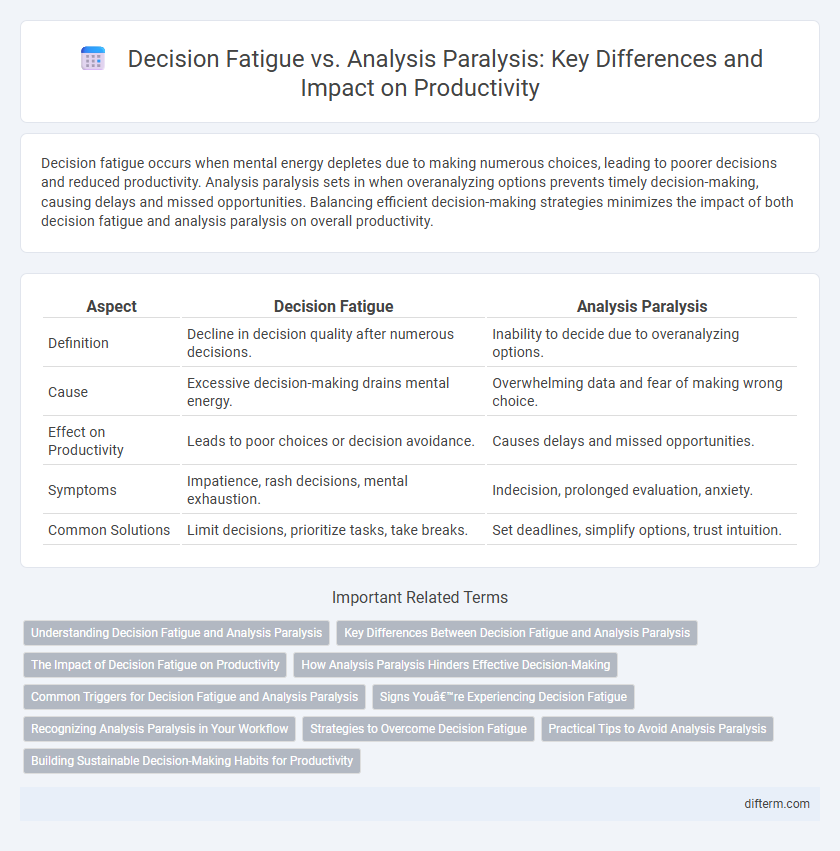Decision fatigue occurs when mental energy depletes due to making numerous choices, leading to poorer decisions and reduced productivity. Analysis paralysis sets in when overanalyzing options prevents timely decision-making, causing delays and missed opportunities. Balancing efficient decision-making strategies minimizes the impact of both decision fatigue and analysis paralysis on overall productivity.
Table of Comparison
| Aspect | Decision Fatigue | Analysis Paralysis |
|---|---|---|
| Definition | Decline in decision quality after numerous decisions. | Inability to decide due to overanalyzing options. |
| Cause | Excessive decision-making drains mental energy. | Overwhelming data and fear of making wrong choice. |
| Effect on Productivity | Leads to poor choices or decision avoidance. | Causes delays and missed opportunities. |
| Symptoms | Impatience, rash decisions, mental exhaustion. | Indecision, prolonged evaluation, anxiety. |
| Common Solutions | Limit decisions, prioritize tasks, take breaks. | Set deadlines, simplify options, trust intuition. |
Understanding Decision Fatigue and Analysis Paralysis
Decision fatigue occurs when the brain's ability to make decisions deteriorates after prolonged decision-making, leading to poor choices and reduced productivity. Analysis paralysis arises from overanalyzing options, causing delays and inability to decide, which hampers workflow efficiency. Recognizing the signs of both mental states enables implementation of strategies such as prioritizing tasks and setting decision limits to maintain optimal focus and productivity throughout the day.
Key Differences Between Decision Fatigue and Analysis Paralysis
Decision fatigue occurs when the brain's ability to make decisions deteriorates after excessive decision-making, leading to poor choices or avoidance, while analysis paralysis involves overthinking or excessive information gathering, causing a complete halt in decision-making. Key differences include decision fatigue's focus on mental exhaustion lowering decision quality, contrasted with analysis paralysis's focus on overanalysis preventing any decision. Recognizing these distinct cognitive processes aids in applying targeted productivity strategies to improve decision efficiency.
The Impact of Decision Fatigue on Productivity
Decision fatigue significantly diminishes productivity by depleting mental energy, leading to poorer choices and slower task execution. As cognitive resources wane throughout the day, individuals struggle to maintain focus and efficiency, causing delays and errors in workflow. Managing decision load through prioritization and routine can mitigate this impact and sustain consistent performance.
How Analysis Paralysis Hinders Effective Decision-Making
Analysis paralysis hinders effective decision-making by overwhelming individuals with excessive information and options, leading to stagnation rather than action. This cognitive overload prevents timely choices, reducing productivity and increasing stress levels. It contrasts with decision fatigue, where declining mental energy impairs judgment quality, but analysis paralysis entirely stalls the decision process.
Common Triggers for Decision Fatigue and Analysis Paralysis
Common triggers for decision fatigue include excessive choices, high-stakes decisions, and constant multitasking, which deplete mental energy and impair judgment. Analysis paralysis often stems from information overload, fear of making the wrong choice, and perfectionism, leading to delayed or avoided decisions. Recognizing these triggers enables improved productivity by streamlining decision-making processes and reducing cognitive strain.
Signs You’re Experiencing Decision Fatigue
Constantly delaying simple choices, such as what to eat or wear, can indicate decision fatigue impairing productivity. Experiencing mental exhaustion after making multiple decisions leads to poorer quality judgments and increased impulsivity. Difficulty focusing and frequent procrastination are clear signs that decision fatigue is affecting your efficiency and cognitive resources.
Recognizing Analysis Paralysis in Your Workflow
Recognizing analysis paralysis in your workflow involves identifying prolonged decision-making delays despite having sufficient information, often caused by overanalyzing options and fearing potential mistakes. Key signs include frequent revisiting of the same problem without resolution and an inability to prioritize tasks effectively. Implementing time limits for evaluations and breaking complex decisions into smaller, manageable steps reduces productivity loss related to analysis paralysis.
Strategies to Overcome Decision Fatigue
To overcome decision fatigue, implement strategies such as prioritizing important decisions earlier in the day when mental energy is higher and simplifying choices by limiting options to reduce cognitive load. Incorporating routines and automating repetitive decisions can conserve willpower for more complex problem-solving tasks. Regular breaks, mindfulness practices, and maintaining physical health through adequate sleep and nutrition also enhance decision-making capacity and overall productivity.
Practical Tips to Avoid Analysis Paralysis
To overcome analysis paralysis, break decisions into smaller, manageable steps and set clear deadlines for each phase to maintain momentum. Prioritize options by establishing criteria based on goals and eliminate less relevant choices early in the process. Leveraging tools like decision matrices or pros-and-cons lists can streamline evaluation and reduce mental overload.
Building Sustainable Decision-Making Habits for Productivity
Decision fatigue significantly lowers productivity by depleting mental energy needed for effective choices, while analysis paralysis stalls progress through overthinking options; building sustainable decision-making habits like setting clear priorities, time-blocking decisions, and limiting choice overload enhances focus and efficiency. Implementing techniques such as standardized routines and decision thresholds reduces cognitive load, enabling consistent productivity gains. Emphasizing these strategies fosters resilience against mental exhaustion and supports long-term goal achievement.
Decision fatigue vs Analysis paralysis Infographic

 difterm.com
difterm.com